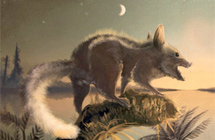考古新发现:人类的祖先是老鼠
|
As ancestors go, it might not look particularly distinguished, but this toothy rat-like creature is the forefather of us all. Remains of the little nocturnal mammal, which lived 145 million years ago, were recently discovered on the Jurassic Coast of Dorset, by paleontologists from the University of Portsmouth. The animal is the earliest in a line that would eventually lead to humans, as well as branching off along the way to evolve into creatures as diverse as Blue Whales and Pigmy Shrews.
The new species has been named ‘Durlstotherim newmani’, after keen amateur paleontologist Charlie Newman, 51, the landlord of the Square and Compass in Worth Matravers who founded his own fossil museum in the pub, and helped scientists collect the new specimens. Mr Newman, made headlines in 2015 when he built his own 12ft high ‘Stonehenge’ using 35 tonnes of timber in a field he owns in the village, although he was later ordered to tear it down by Purbeck District Council. The new species were identified from just a handful of fossilised teeth which were found by Portsmouth University undergraduate Grant Smith earlier this year, and identified by Dr Steve Sweetman, a research fellow at the university. Dr Sweetman said: “Grant was sifting through small samples of earliest Cretaceous rocks collected on the coast of Dorset as part of his undergraduate dissertation project in the hope of finding some interesting remains. “Quite unexpectedly he found not one but two quite remarkable teeth of a type never before seen from rocks of this age. I was asked to look at them and give an opinion and even at first glance my jaw dropped. “The teeth are of a type so highly evolved that I realised straight away I was looking at remains of Early Cretaceous mammals that more closely resembled those that lived during the latest Cretaceous - some 60 million years later in geological history. “The specimen is named after a pub landlord because he is a keen amateur paleontologist and has a small museum in his pub. He helped us collect samples and was otherwise very helpful and hospitable.” Dr Sweetman believes the mammal was a small, furry creature and most likely nocturnal. A second species was also identified and named after scientist, Paul Ensom. The creatures probably lived in burrows feeding on insects, or plants.
“They are also very worn which suggests the animals to which they belonged lived to a good age for their species. No mean feat when you’re sharing your habitat with predatory dinosaurs.” The teeth were recovered from rocks exposed in cliffs near Swanage which has given up thousands of iconic fossils.
Mammal teeth evolved over time, from very simple ones that were not very efficient, to molar-like ridged teeth which could tear, chew and grind food very easily. Teeth as well-evolved as Durlstotherim newmani, have previously only been found in rock layers from, the late Cretaceous, between 86 and 66 million years ago. Professor Martill said: “We looked at them with a microscope but despite over 30 years’ experience these teeth looked very different. Steve made the connection immediately. “The Jurassic Coast is always unveiling fresh secrets and I’d like to think that similar discoveries will continue to be made right on our doorstep.” Dr Sweetman said the finds rewrite the history of mammal evolution. “In the world of palaeontology there has been a lot of debate around a specimen found in China, which is approximately 160 million years old,” he added. “This was originally said to be of the same type as ours but recent studies have ruled this out. That being the case, our 145 million year old teeth are undoubtedly the earliest yet known from the line of mammals that lead to our own species.” |









